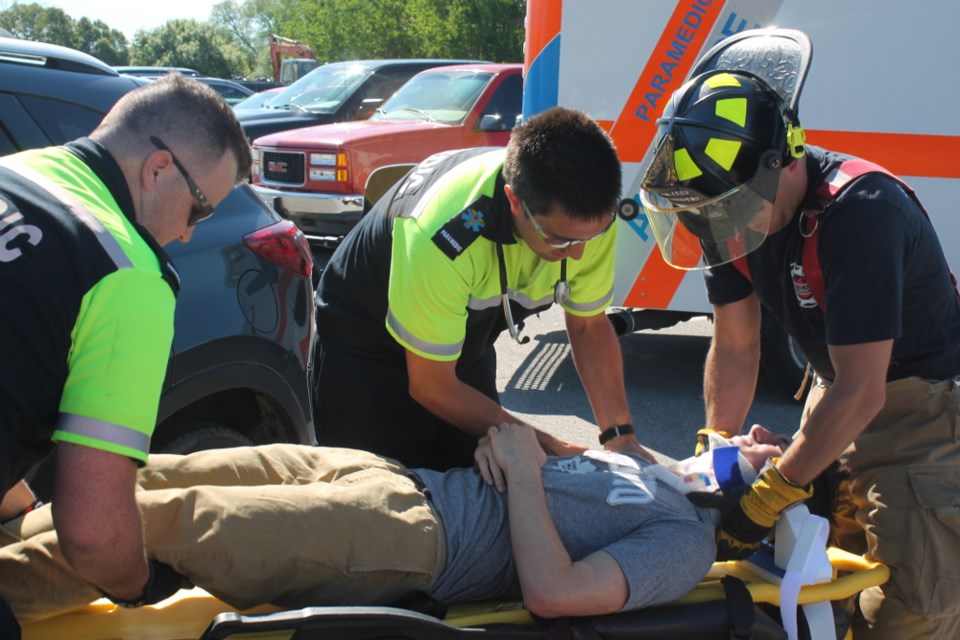Changes to Ontario’s Ambulance Act, if passed, could lead to paramedics transporting patients in non-urgent medical need to medical centres other than hospitals.
The move is designed to take pressure off hospital emergency departments, such as that at Sault Area Hospital.
“Providing more flexibility would allow patients to receive the most appropriate care while reducing unnecessary trips to emergency departments,” the province stated in a news release issued Monday by the Ministry of Health and Long-Term Care.
The changes to the Ambulance Act will come “through a transparent and inclusive consultation process,” the government says.
“The way the Ambulance Act is written right now, we need to take patients to the hospitals. If we pick somebody up who needs stitches for instance, we don’t have the option of saying ‘you know what, the clinic in the west end can take care of this for you, we can take you there,’ our obligation is we need to go to the hospitals with patients who require treatment,” said Robert Rushworth, Sault Emergency Medical Services (EMS) deputy chief.
“The Group Health Centre (for example) may be a place where there is a clinic that handles minor problems, diverting the workload from the hospitals…giving the right patient the right care at the right time,” Rushworth told SooToday.
Group Health Centre and Sault Area Hospital officials were not immediately available for comment Wednesday.
The province will be spending money on a new medical dispatch system that will prioritize 911 calls for ambulance services.
The new medical dispatch system is expected to be set up at its first site in Ontario by March 2018, with full roll-out expected to take about 24 months.
“It’s a major change, the technology behind it will take time,” Rushworth said.
The changes to the Ambulance Act will give paramedics the ability and authority to perform on-scene evaluation of patients, including treatment and referral to non-hospital options, and in other cases, treatment and release of patients, the province says.
There is currently a combination of 56 full-time and part-time EMS paramedics in Sault Ste. Marie.
“It could change the whole college program for new paramedics, it could change the whole education process for the dispatchers because they’re going to be a big part of this,” Rushworth said.
“It’ll make the paramedics more clinicians than technicians (in treating patients who are diabetic, for example, on the spot, instead of taking them to hospital), they’re going to have to learn deeper assessment (of a patient’s needs).”
“I think it’s a very positive thing for the paramedic profession. There are many times when the paramedics recognize the hospital’s not the right place for a person, but that’s where they’re obligated to take them,” Rushworth said.
“We’re looking forward to that, it’ll be a great change,” Rushworth said.
Meanwhile, Sault EMS paramedics, under a pilot project known as the Withdrawal Management Diversion Strategy, will be able to directly transport patients suffering from alcohol or drug-related problems directly to Sault Area Hospital’s detoxification facility on Queen Street East, bypassing the hospital’s emergency department, effective Monday, June 12.
“They have a diversion strategy in Sudbury right now where they’re diverting certain patients who meet the criteria to a withdrawal management service, like a detox, as well as mental health. We adopted just the withdrawal management diversion aspect of it,” said Daniel Langevin, Sault EMS professional standards, training and development deputy chief.
“If a patient meets the criteria, we can call the detox centre on Queen Street and ask them if they’re willing to accept the patient and if they are we can transport that patient there, after proper assessment.”
“It’s more for the low acuity patients who are willing to accept help. It’s a better fit for them to go to detox than being in the hospital emergency department,” Langevin said.
It is estimated the diversion of local patients to detox may involve 20 to 30 patients annually, Sault EMS officials said.
Treatment criteria includes the patient being conscious and cooperative, willing to accept help and be transported to the detox centre, Langevin said.
If a patient, however, has had a drug overdose and needs Narcan, that patient will be taken to Sault Area Hospital, Langevin said.
The detox centre on Queen Street is a branch of Sault Area Hospital, “so it made it a little easier for us to get this going. We did some pre-training this spring.”
Approval for the pilot project was required from the Ministry of Health, northeastern Ontario district medical officials based at Sudbury’s Health Sciences Centre, Sault Area Hospital and the local dispatch centre.
The broader, province-wide changes to the Ambulance Act have not yet been officially announced in the Ontario Legislature.
